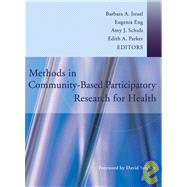
Note: Supplemental materials are not guaranteed with Rental or Used book purchases.
Purchase Benefits
What is included with this book?
Eugenia Eng is professor of health behavior and health education in the School of Public Health at the University of North Carolina at Chapel Hill.
Amy J. Schulz is research associate professor of health behavior and health education at the University of Michigan School of Public Health.
Edith A. Parker is associate professor of health behavior and health education at the University of Michigan School of Public Health.
|
|||
|
|||
|
|||
|
|||
|
|||
| PART ONE: INTRODUCTION TO METHODS IN COMMUNITY-BASED PARTICIPATORY RESEARCH FOR HEALTH. | |||
|
|||
| PART TWO: PARTNERSHIP FORMATION AND MAINTENANCE. | |||
|
|||
|
|||
| PART THREE: COMMUNITY ASSESSMENT AND DIAGNOSIS. | |||
|
|||
| PART FOUR: DEFINITION OF THE ISSUE. | |||
|
|||
|
|||
|
|||
|
|||
|
|||
|
|||
|
|||
| PART FIVE: DOCUMENTATION AND EVALUATION OF PARTNERSHIPS. | |||
|
|||
| PART SIX: FEEDBACK, INTERPRETATION, DISSEMINATION, AND APPLICATION OF RESULTS. | |||
|
|||
|
|||
|
|||
|
|||
|
|||
|
|||
|
|||
|
|||
|
|||
| APPENDIXES. | |||
|
|||
|
|||
|
|||
|
|||
|
|||
|
|||
|
|||
|
|||
|
|||
|
|||
|
|||
|
|||
|
|||
|
|||
|
|||
|
|||
|
|||
|
The New copy of this book will include any supplemental materials advertised. Please check the title of the book to determine if it should include any access cards, study guides, lab manuals, CDs, etc.
The Used, Rental and eBook copies of this book are not guaranteed to include any supplemental materials. Typically, only the book itself is included. This is true even if the title states it includes any access cards, study guides, lab manuals, CDs, etc.